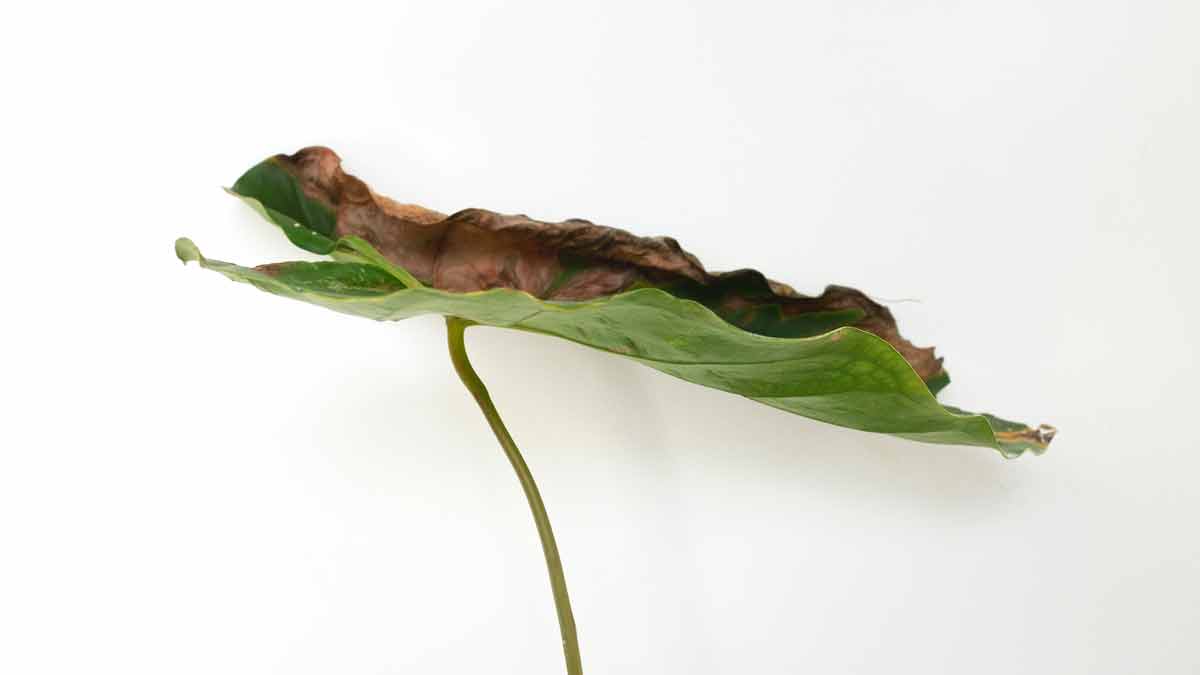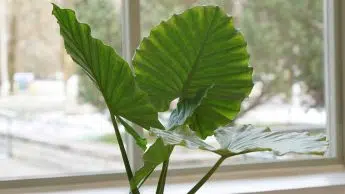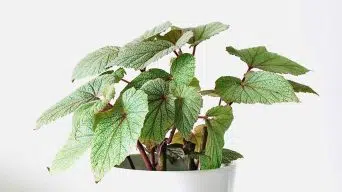Brown leaves on Elephant Ear plants can be caused by overwatering or fungal diseases. Leaf burn from too much direct sunlight or heat, fertilizer burn, and pests can also be culprits. To fix, ensure proper watering, temperature, and sunlight conditions. Prune damaged leaves and mist plant leaves.
Elephant ear plants, with their large and stunning leaves, are a favorite among plant enthusiasts.
However, when those magnificent leaves start turning brown, it can be worrisome and disheartening.
In this article, we’ll explore the common causes behind your Elephant ear plant’s browning leaves – from overwatering to pests – and share expert solutions to help you bring your beloved green companion back to its vibrant best.
Common Causes Of Brown Elephant Ear Leaves
Brown elephant ear leaves can result from a range of factors such as overwatering, underwatering, sunburn or frost damage, nutrient imbalances, and pest or fungal infections.
These issues can affect the health and appearance of elephant ear plants, making it crucial to promptly identify and address the underlying causes.
Overwatering Or Underwatering
One common cause of brown elephant ear leaves is inconsistent watering habits, either providing too much or too little water.
Overwatering can lead to root rot, which suffocates the plant’s roots and causes them to decay.
As oxygen supply decreases and harmful organisms multiply in the soggy soil, your elephant ear plant struggles to take up nutrients, leading to browning and potentially death if left unaddressed.
Conversely, underwatering subjects the plants to drought stress as it prevents the uptake of essential nutrients required for healthy growth.
To maintain optimal health for your elephant ear plants, carefully monitor their watering needs by implementing a consistent schedule based on various factors such as outdoor temperature and humidity levels.
For example, during hot summer months when evaporation rates are higher due to low humidity levels, you may need to water your outdoor-grown elephant ears more frequently than when grown indoors with regulated conditions throughout the year.
Sunburn Or Frost Damage
Sunburn and frost damage are two common causes of elephant ear plant leaves turning brown.
These tropical plants thrive in warm temperatures and can be sensitive to sudden environmental changes.
Exposing an elephant ear plant to direct sunlight for extended periods, especially during the hot summer, can lead to sunburned leaves.
The scorching rays cause the leaf tissue to dry out or become discolored, leaving behind unsightly brown spots.
To prevent sunburn or frost damage on your elephant ear plant’s leaves, providing adequate growing conditions that mimic its natural habitat is crucial.
Position your alocasia plant where it receives bright indirect sunlight instead of direct sun exposure.
This will minimize the risk of sunburn while still providing enough light for healthy growth.
Additionally, protect your indoor plants from drafts near windows and doors during cold weather by temporarily relocating them or using insulation materials like draft stoppers around affected areas.
For outdoor planting, consider situating your elephant ears in sheltered locations such as under larger trees or structures offering protection from harsh temperature fluctuations throughout different seasons.
Nutrient Deficiencies Or Excesses
Nutrient imbalances can be a common reason behind elephant ear plant leaves turning brown.
Deficiencies and excesses lead to various problems that ultimately harm the plant’s health.
In contrast, overfertilizing your elephant ear plants can create nutrient toxicities that damage their roots or foliage.
This could manifest as brown spots on your beautiful green leaves due to concentrations of certain elements like salts from synthetic fertilizers accumulating in the soil.
To address this issue, use a well-balanced fertilizer for tropical plants like elephant ears and follow the recommended application rates on the product label.
If you suspect nutrient deficiencies are causing your problem with brown leaves on your elephant ear plant, consider conducting a soil test before taking any corrective measures.
A thorough analysis will reveal specific needs for amending your garden beds to provide optimal nutrition levels for healthy growth without inviting additional stressors – such as fungal diseases caused by an immune-compromised plant trying to cope under less-than-ideal conditions (e.g., low humidity during peak heatwaves).
Pest Or Fungal Infestations
Pest or fungal infestations are common causes of brown elephant ear leaves.
Various pests, such as spider mites, aphids, and mealybugs, can cause these issues.
Fungal diseases like bacterial leaf spot and fungal leaf blight can also cause damage to the leaves.
Pests and fungi often thrive in warm and humid environments, so watching for signs of an infestation is important.
Fortunately, solutions are available to prevent or address pest or fungal infestations.
One option is using insecticidal soap, which can control many types of pests without leaving harmful residue on the plant.
Another solution involves applying a fungicide spray that effectively targets different plant fungus types.
In addition, adding Epsom salt into the soil once per month can help boost resistance against certain diseases while improving overall plant health with added magnesium sulfate nutrients in its system.
Solutions To Brown Elephant Ear Leaves
If your Elephant Ear leaves have turned brown, don’t worry, there are solutions to revive them.
You can start by adjusting your watering habits, providing proper sunlight and temperature conditions, addressing fungal or pest issues, and using the right soil type and fertilization levels.
Following these solutions can bring your elephant ear plant back to life.
Adjusting Watering Habits
If you notice that your Elephant Ear plant leaves are turning brown, adjusting your watering habits is one solution to the problem.
Here’s what you can do:
- Always check the soil moisture level before watering your Elephant Ear plant. Poke your finger into the soil about an inch deep – if it feels dry, it’s time to water. Hold off watering for a few more days if it still feels moist.
- Avoid overwatering your plant, as this can cause root rot and brown leaves. To prevent this from happening, ensure the soil is well-draining, and don’t let your plant sit in standing water.
- If underwatering is causing brown leaves, ensure to water your Elephant Ear plant regularly but not too much at once. Water deeply until the excess water drains out of the pot, ensuring the roots get enough nutrients.
- Incorporate Epsom salt into your watering schedule once or twice a month to boost magnesium sulfate, which supports healthy foliage growth.
- Another tip is to frequently mist your Elephant Ear with water if you live in a low humidity area or during a hot summer because these plants thrive in moist air environments.
Providing Proper Sunlight And Temperature Conditions
Proper sunlight and temperature conditions are crucial to ensure elephant ear plants’ optimal growth and prevent brown leaves.
Here are some tips:
- Elephant ear plants thrive in bright, indirect sunlight. Avoid direct sunlight, as it can cause sunburn that leads to brown spots on the leaves.
- Keep your plant in a warm area with a temperature range of 65°F to 80°F for best results.
- If you’re growing elephant ear plants indoors, place them near a south-facing window or provide supplemental light using grow lights.
- During winter, keep the plant away from cold drafts, as temperatures below 55°F can damage the leaves.
- Installing a humidifier or placing the plant on a tray filled with pebbles and water can also help maintain proper humidity levels for optimal growth.
Adjusting Fertilization And Nutrient Levels
Adjusting fertilization and nutrient levels can be an effective solution to prevent brown Elephant Ear leaves.
Here are some things to keep in mind:
- Provide proper nutrients: Ensure the plant has the right balance of essential macronutrients such as nitrogen, phosphorus, and potassium. Use a balanced fertilizer equal to all three, or choose one higher in nitrogen for leafy growth.
- Avoid over-fertilization: Over-fertilizing the elephant ear’s soil can also cause browning of the leaves. Be cautious not to use too much, as it can burn or damage the plant.
- Add Epsom salt: Adding 1-2 tablespoons of Epsom salt per gallon of water monthly can provide magnesium, sulfur, and other minerals that promote healthy foliage growth.
- Adjust pH levels: Elephant ear plants prefer a slightly acidic soil between the 5.5 and 6.5 pH range which is optimal for nutrient absorption.
By following these steps, you can maintain your elephant ear plant’s overall health and appearance and prevent brown leaves from developing due to nutrient deficiencies or excesses.
Addressing Pest Or Fungal Issues
Fungal leaf blight and bacterial leaf spot are the two most common fungal infections that cause brown Elephant Ear leaves.
Here is how to address pest or fungal issues in your elephant ear plant:
- Use fungicides: Fungicides can help prevent and control fungal infections in your elephant ear plant. Look for a fungicide that is effective against the specific fungus affecting your plant.
- Improve drainage: Poor drainage can contribute to fungal growth in soil, so ensuring your plant has good drainage is important. Add perlite or sand to the soil mix to increase drainage.
- Adjust watering schedules: Overwatering can cause root rot, which makes the plant more susceptible to pests and fungal infections. Water only when the top inch of soil feels dry.
- Remove affected leaf: If you notice a leaf with signs of infection, remove it immediately to prevent the further spread of the disease.
- Keep humidity levels up: Elephant ear plants thrive in high humidity environments, which also helps prevent pest and fungal infestations.
Using The Right Soil Type
Choosing the right soil type ensures your elephant ear plant remains healthy and strong.
Elephant ears prefer well-draining, moist soil that is rich in organic matter.
Avoid using heavy or compacted soils, leading to waterlogging and root rot.
Additionally, adding perlite, vermiculite, or sand can help improve drainage if your soil tends to be too heavy.
Choosing The Right Environment For Growth
Creating the right environment for your Elephant Ear Plant is crucial to its growth and health.
These plants prefer bright indirect sunlight or partial shade when it comes to lighting.
Direct sunlight can scorch their leaves, causing them to turn brown or yellow.
Regarding soil type, Elephant Ear Plants thrive in a well-draining soil mix that retains moisture without becoming soggy.
Avoid using heavy clay-based soils, which can cause problems such as root rot and fungal infections.
Lastly, keep your plant away from extreme temperatures, which can cause stress on its delicate structure, leading to the browning of Elephant Ear leaves.
Preventing Brown Elephant Ear Leaves
To prevent brown Elephant Ear leaves, proactive measures are necessary.
These include proper planting techniques, soil preparation, and consistent monitoring of watering and fertilization.
Additionally, the plant should be protected from direct sunlight and extreme temperatures, pruned regularly, and given proper mulch.
By implementing these strategies, gardeners can ensure the Elephant Ear plant remains healthy and vibrant.
Proper Planting And Soil Preparation
Proper planting and soil preparation are crucial in preventing brown elephant ear leaves.
Here’s what you need to know:
- Choose a location that offers bright, indirect sunlight or partial shade, depending on the plant’s needs.
- Choose the correct type of soil for your elephant ear plant. A well-draining potting mix with ample nutrients is recommended.
- Before planting, water the soil thoroughly to ensure it is moist but not waterlogged.
- Plant the elephant ear bulb or rhizome at a depth of about 2-3 inches in the prepared soil, not damaging any existing roots.
- Water the plant immediately after planting and monitor closely for the first few weeks as it establishes itself in its new environment.
- Consider adding mulch around the base of the plant to help retain moisture and regulate temperature.
Regular Inspection And Care
Regular inspection and care is crucial in preventing brown elephant ear leaves.
As plant enthusiasts, it’s important to monitor your plants regularly and address any issues as soon as they arise.
By catching any problems early on and promptly addressing them, you can avoid brown elephant ear leaves altogether.
Remember that prevention is critical when it comes to maintaining healthy plants.
Consistent Monitoring Of Watering And Fertilization
Consistent monitoring of watering and fertilization is crucial in preventing brown elephant ear leaves.
Underwatering or overwatering the plant can cause yellowing, wilting, and browning of the foliage.
It’s essential to ensure that the soil is moist but not soggy. As for fertilization, too much or too little nutrients can lead to brown leaves.
To help maintain proper moisture levels in the soil, consider investing in a moisture meter.
This tool helps you determine when it’s time to water your plant by measuring the moisture in the soil.
Keeping The Plant Out Of Direct Sunlight And Extreme Temperatures
One of the most important things to remember when caring for your elephant ear plant is to ensure that it is not subjected to direct sunlight or extreme temperatures.
This is because these conditions can cause the plant’s leaves to turn brown and dry out, making it difficult for them to absorb nutrients properly.
If you’re growing this tropical plant outdoors, provide some shade during peak sun hours by using a tree canopy or positioning it under an overhang.
Additionally, if you have air conditioning or heating units in your home, be aware that they can affect the temperature around the plant and adjust accordingly.
Regular Pruning And Trimming
Regular pruning and trimming are essential for the overall health of your elephant ear plant.
This helps promote healthy growth, prevent overcrowding, and reduce disease risk.
Here are some tips to ensure that you prune and trim your elephant ear plant correctly:
- Use sharp and clean tools: Using sharp and clean tools will help prevent damage and infection to your plant.
- Remove damaged or discolored leaves: Removing damaged or discolored leaves will not only improve the appearance of your plant but also prevent the disease from spreading.
- Trim dead or brown stems: Trimming dead or brown stems will help promote new growth in healthy areas of the plant.
- Prune overcrowded areas: Overcrowded areas can lead to poor air circulation and increase disease risk. Prune any crowded regions to promote good airflow.
- Don’t over-prune: While pruning is important for your plant’s health, don’t overdo it. Only remove what is necessary for optimal growth.
Using Mulch
Mulching is an effective way to prevent brown Elephant Ear leaves caused by dry spells.
Applying a 2- to 3-inch thick layer of organic mulch, such as straw, around the base of the plant can help retain moisture in the soil and keep it from drying out too quickly.
This not only helps prevent brown leaves but also promotes healthy growth overall.
In addition, mulching keeps weeds at bay and adds nutrients back into the soil over time as it breaks down.
Final Thoughts
Brown leaves on your elephant ear plant can be alarming.
Still, you can help your beloved plant thrive again with the correct information and techniques!
Inspect your plant regularly for pests or fungal infections, adjust watering habits as needed, provide proper sunlight and temperature conditions, fertilize appropriately, and choose the right soil type.
Prevention is vital to ensuring that brown leaves don’t show up in the first place.







